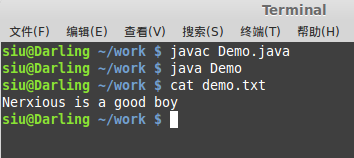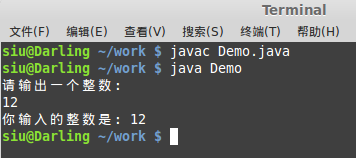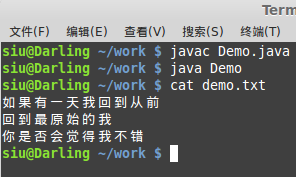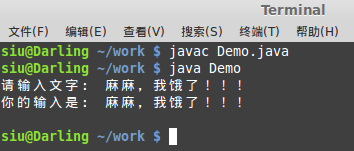标签:
所谓IO,也就是Input与Output的缩写。在java中,IO涉及的范围比较大,这里主要讨论针对文件内容的读写
其他知识点将放置后续章节(我想,文章太长了,谁都没耐心翻到最后)
对于文件内容的操作主要分为两大类
分别是:
字符流
字节流
其中,字符流有两个抽象类:Writer Reader
其对应子类FileWriter和FileReader可实现文件的读写操作
BufferedWriter和BufferedReader能够提供缓冲区功能,用以提高效率
同样,字节流也有两个抽象类:InputStream OutputStream
其对应子类有FileInputStream和FileOutputStream实现文件读写
BufferedInputStream和BufferedOutputStream提供缓冲区功能
俺当初学IO的时候犯了不少迷糊,网上有些代码也无法通过编译,甚至风格都很大不同,所以新手请注意:
1.本文代码较长,不该省略的都没省略,主要是因为作为一个新手需要养成良好的代码编写习惯
2.本文在linux下编译,类似于File.pathSeparator和File.separator这种表示方法是出于跨平台性和健壮性考虑
3.代码中有些操作有多种执行方式,我采用了方式1...方式2...的表述,只需轻轻解开注释便可编译
4.代码中并没有在主方法上抛出异常,而是分别捕捉,造成代码过长,如果仅是测试,或者不想有好的编程习惯,那你就随便抛吧……
5.功能类似的地方就没有重复写注释了,如果新手看不懂下面的代码,那肯定是上面的没有理解清楚
|
1
2
3
4
5
6
7
8
9
10
11
12
13
14
15
16
17
18
19
20
21
22
23
24
25
26
27
28
29
30
31
32
33
34
35
36
37
38
39
|
import java.io.File;
import java.io.FileWriter;
import java.io.IOException;
public class Demo {
public static void main(String[] args ) {
//创建要操作的文件路径和名称
//其中,File.separator表示系统相关的分隔符,Linux下为:/ Windows下为:\
String path = File.separator + "home" + File.separator + "siu" +
File.separator + "work" + File.separator + "demo.txt";
//由于IO操作会抛出异常,因此在try语句块的外部定义FileWriter的引用
FileWriter w = null;
try {
//以path为路径创建一个新的FileWriter对象
//如果需要追加数据,而不是覆盖,则使用FileWriter(path,true)构造方法
w = new FileWriter(path);
//将字符串写入到流中,\r\n表示换行想有好的
w.write("Nerxious is a good boy\r\n");
//如果想马上看到写入效果,则需要调用w.flush()方法
w.flush();
} catch (IOException e) {
e.printStackTrace();
} finally {
//如果前面发生异常,那么是无法产生w对象的
//因此要做出判断,以免发生空指针异常
if(w != null) {
try {
//关闭流资源,需要再次捕捉异常
w.close();
} catch (IOException e) {
e.printStackTrace();
}
}
}
}
}
|
编译之后,在目录下面生成文件,并写入字符串

|
1
2
3
4
5
6
7
8
9
10
11
12
13
14
15
16
17
18
19
20
21
22
23
24
25
26
27
28
29
30
31
32
33
34
35
36
37
38
39
40
41
42
43
44
45
46
47
48
49
50
51
52
53
54
55
56
57
58
59
60
61
62
63
64
65
66
67
68
69
70
71
72
73
74
|
import java.io.File;
import java.io.FileReader;
import java.io.IOException;
public class Demo2 {
public static void main(String[] args ) {
String path = File.separator + "home" + File.separator + "siu" +
File.separator + "work" + File.separator + "demo.txt";
FileReader r = null;
try {
r = new FileReader(path);
//方式一:读取单个字符的方式
//每读取一次,向下移动一个字符单位
int temp1 = r.read();
System.out.println((char)temp1);
int temp2 = r.read();
System.out.println((char)temp2);
//方式二:循环读取
//read()方法读到文件末尾会返回-1
/*
while (true) {
int temp = r.read();
if (temp == -1) {
break;
}
System.out.print((char)temp);
}
*/
//方式三:循环读取的简化操作
//单个字符读取,当temp不等于-1的时候打印字符
/*int temp = 0;
while ((temp = r.read()) != -1) {
System.out.print((char)temp);
}
*/
//方式四:读入到字符数组
/*
char[] buf = new char[1024];
int temp = r.read(buf);
//将数组转化为字符串打印,后面参数的意思是
//如果字符数组未满,转化成字符串打印后尾部也许会出现其他字符
//因此,读取的字符有多少个,就转化多少为字符串
System.out.println(new String(buf,0,temp));
*/
//方式五:读入到字符数组的优化
//由于有时候文件太大,无法确定需要定义的数组大小
//因此一般定义数组长度为1024,采用循环的方式读入
/*
char[] buf = new char[1024];
int temp = 0;
while((temp = r.read(buf)) != -1) {
System.out.print(new String(buf,0,temp));
}
*/
} catch (IOException e) {
e.printStackTrace();
} finally {
if(r != null) {
try {
r.close();
} catch (IOException e) {
e.printStackTrace();
}
}
}
}
}
|
编译之后的效果:

|
1
2
3
4
5
6
7
8
9
10
11
12
13
14
15
16
17
18
19
20
21
22
23
24
25
26
27
28
29
30
31
32
33
34
35
36
37
38
39
40
41
42
43
44
45
46
47
48
49
50
51
52
53
54
55
56
|
import java.io.File;
import java.io.FileReader;
import java.io.FileWriter;
import java.io.IOException;
public class Demo {
public static void main(String[] args ) {
String doc = File.separator + "home" + File.separator + "siu" +
File.separator + "work" + File.separator + "demo.txt";
String copy = File.separator + "home" + File.separator + "siu" +
File.separator + "life" + File.separator + "lrc.txt";
FileReader r = null;
FileWriter w = null;
try {
r = new FileReader(doc);
w = new FileWriter(copy);
//方式一:单个字符写入
int temp = 0;
while((temp = r.read()) != -1) {
w.write(temp);
}
//方式二:字符数组方式写入
/*
char[] buf = new char[1024];
int temp = 0;
while ((temp = r.read(buf)) != -1) {
w.write(new String(buf,0,temp));
}
*/
} catch (IOException e) {
e.printStackTrace();
} finally {
//分别判断是否空指针引用,然后关闭流
if(r != null) {
try {
r.close();
} catch (IOException e) {
e.printStackTrace();
}
}
if(w != null) {
try {
w.close();
} catch (IOException e) {
e.printStackTrace();
}
}
}
}
}
|
编译之后,产生life目录下的lrc.txt文件,复制成功

|
1
2
3
4
5
6
7
8
9
10
11
12
13
14
15
16
17
18
19
20
21
22
23
24
25
26
27
28
29
30
31
32
33
34
35
36
37
38
39
40
41
42
43
44
45
46
47
48
49
50
51
52
53
54
55
56
57
58
59
60
61
62
63
64
65
|
import java.io.BufferedReader;
import java.io.BufferedWriter;
import java.io.File;
import java.io.FileReader;
import java.io.FileWriter;
import java.io.IOException;
public class Demo {
public static void main(String[] args ) {
String doc = File.separator + "home" + File.separator + "siu" +
File.separator + "work" + File.separator + "demo.txt";
String copy = File.separator + "home" + File.separator + "siu" +
File.separator + "life" + File.separator + "lrc.txt";
FileReader r = null;
FileWriter w = null;
//创建缓冲区的引用
BufferedReader br = null;
BufferedWriter bw = null;
try {
r = new FileReader(doc);
w = new FileWriter(copy);
//创建缓冲区对象
//将需要提高效率的FileReader和FileWriter对象放入其构造函数内
//当然,也可以使用匿名对象的方式 br = new BufferedReader(new FileReader(doc));
br = new BufferedReader(r);
bw = new BufferedWriter(w);
String line = null;
//读取行,直到返回null
//readLine()方法只返回换行符之前的数据
while((line = br.readLine()) != null) {
//使用BufferWriter对象的写入方法
bw.write(line);
//写完文件内容之后换行
//newLine()方法依据平台而定
//windows下的换行是\r\n
//Linux下则是\n
bw.newLine();
}
} catch (IOException e) {
e.printStackTrace();
} finally {
//此处不再需要捕捉FileReader和FileWriter对象的异常
//关闭缓冲区就是关闭缓冲区中的流对象
if(br != null) {
try {
r.close();
} catch (IOException e) {
e.printStackTrace();
}
}
if(bw != null) {
try {
bw.close();
} catch (IOException e) {
e.printStackTrace();
}
}
}
}
}
|
|
1
2
3
4
5
6
7
8
9
10
11
12
13
14
15
16
17
18
19
20
21
22
23
24
25
26
27
28
29
30
31
32
33
34
|
import java.io.File;
import java.io.FileOutputStream;
import java.io.IOException;
public class Demo {
public static void main(String[] args ) {
String path = File.separator + "home" + File.separator + "siu" +
File.separator + "work" + File.separator + "demo.txt";
FileOutputStream o = null;
try {
o = new FileOutputStream(path);
String str = "Nerxious is a good boy\r\n";
byte[] buf = str.getBytes();
//也可以直接使用o.write("String".getBytes());
//因为字符串就是一个对象,能直接调用方法
o.write(buf);
} catch (IOException e) {
e.printStackTrace();
} finally {
if(o != null) {
try {
o.close();
} catch (IOException e) {
e.printStackTrace();
}
}
}
}
}
|
编译之后产生的文件,以上在字符串中加\r\n就是为了便于终端显示
其实在linux下面换行仅用\n即可

|
1
2
3
4
5
6
7
8
9
10
11
12
13
14
15
16
17
18
19
20
21
22
23
24
25
26
27
28
29
30
31
32
33
34
35
36
37
38
39
40
41
42
43
44
45
46
47
48
49
50
51
52
53
54
55
56
57
58
59
|
import java.io.File;
import java.io.FileInputStream;
import java.io.IOException;
public class Demo {
public static void main(String[] args ) {
String path = File.separator + "home" + File.separator + "siu" +
File.separator + "work" + File.separator + "demo.txt";
FileInputStream i = null;
try {
i = new FileInputStream(path);
//方式一:单个字符读取
//需要注意的是,此处我用英文文本测试效果良好
//但中文就悲剧了,不过下面两个方法效果良好
int ch = 0;
while((ch=i.read()) != -1){
System.out.print((char)ch);
}
//方式二:数组循环读取
/*
byte[] buf = new byte[1024];
int len = 0;
while((len = i.read(buf)) != -1) {
System.out.println(new String(buf,0,len));
}
*/
//方式三:标准大小的数组读取
/*
//定一个一个刚好大小的数组
//available()方法返回文件的字节数
//但是,如果文件过大,内存溢出,那就悲剧了
//所以,亲们要慎用!!!上面那个方法就不错
byte[] buf = new byte[i.available()];
i.read(buf);
//因为数组大小刚好,所以转换为字符串时无需在构造函数中设置起始点
System.out.println(new String(buf));
*/
} catch (IOException e) {
e.printStackTrace();
} finally {
if(i != null) {
try {
i.close();
} catch (IOException e) {
e.printStackTrace();
}
}
}
}
}
|
读取文件到终端

|
1
2
3
4
5
6
7
8
9
10
11
12
13
14
15
16
17
18
19
20
21
22
23
24
25
26
27
28
29
30
31
32
33
34
35
36
37
38
39
40
41
42
43
44
45
46
47
48
|
import java.io.File;
import java.io.FileInputStream;
import java.io.FileOutputStream;
import java.io.IOException;
public class Demo {
public static void main(String[] args ) {
String bin = File.separator + "home" + File.separator + "siu" +
File.separator + "work" + File.separator + "一个人生活.mp3";
String copy = File.separator + "home" + File.separator + "siu" +
File.separator + "life" + File.separator + "一个人生活.mp3";
FileInputStream i = null;
FileOutputStream o = null;
try {
i = new FileInputStream(bin);
o = new FileOutputStream(copy);
//循环的方式读入写出文件,从而完成复制
byte[] buf = new byte[1024];
int temp = 0;
while((temp = i.read(buf)) != -1) {
o.write(buf, 0, temp);
}
} catch (IOException e) {
e.printStackTrace();
} finally {
if(i != null) {
try {
i.close();
} catch (IOException e) {
e.printStackTrace();
}
}
if(o != null) {
try {
o.close();
} catch (IOException e) {
e.printStackTrace();
}
}
}
}
}
|
复制效果,如图:

|
1
2
3
4
5
6
7
8
9
10
11
12
13
14
15
16
17
18
19
20
21
22
23
24
25
26
27
28
29
30
31
32
33
34
35
36
37
38
39
40
41
42
43
44
45
46
47
48
49
50
51
52
53
|
import java.io.BufferedInputStream;
import java.io.BufferedOutputStream;
import java.io.File;
import java.io.FileInputStream;
import java.io.FileOutputStream;
import java.io.IOException;
public class Demo {
public static void main(String[] args ) {
String bin = File.separator + "home" + File.separator + "siu" +
File.separator + "work" + File.separator + "一个人生活.mp3";
String copy = File.separator + "home" + File.separator + "siu" +
File.separator + "life" + File.separator + "一个人生活.mp3";
FileInputStream i = null;
FileOutputStream o = null;
BufferedInputStream bi = null;
BufferedOutputStream bo = null;
try {
i = new FileInputStream(bin);
o = new FileOutputStream(copy);
bi = new BufferedInputStream(i);
bo = new BufferedOutputStream(o);
byte[] buf = new byte[1024];
int temp = 0;
while((temp = bi.read(buf)) != -1) {
bo.write(buf,0,temp);
}
} catch (IOException e) {
e.printStackTrace();
} finally {
if(bi != null) {
try {
i.close();
} catch (IOException e) {
e.printStackTrace();
}
}
if(bo != null) {
try {
o.close();
} catch (IOException e) {
e.printStackTrace();
}
}
}
}
}
|
两个目录都有 “一个人生活.mp3”文件,顺便说一下,这歌挺好听的

初学者在学会使用字符流和字节流之后未免会产生疑问:什么时候该使用字符流,什么时候又该使用字节流呢?
其实仔细想想就应该知道,所谓字符流,肯定是用于操作类似文本文件或者带有字符文件的场合比较多
而字节流则是操作那些无法直接获取文本信息的二进制文件,比如图片,mp3,视频文件等
说白了在硬盘上都是以字节存储的,只不过字符流在操作文本上面更方便一点而已
此外,为什么要利用缓冲区呢?
我们知道,像迅雷等下载软件都有个缓存的功能,硬盘本身也有缓冲区
试想一下,如果一有数据,不论大小就开始读写,势必会给硬盘造成很大负担,它会感觉很不爽
人不也一样,一顿饭不让你一次吃完,每分钟喂一勺,你怎么想?
因此,采用缓冲区能够在读写大文件的时候有效提高效率
这一节我们来讨论关于文件自身的操作
不浪费唾沫了,用代码说话……
|
1
2
3
4
5
6
7
8
9
10
11
12
13
14
15
16
17
18
19
20
21
22
23
24
25
26
27
28
29
30
31
32
|
import java.io.File;
public class Demo {
public static void main(String[] args) {
//创建要操作的文件路径和名称
//其中,File.separator表示系统相关的分隔符,Linux下为:/ Windows下为:\
//path在此程序里面代表父目录,不包含子文件
String path = File.separator + "home" + File.separator + "siu" +
File.separator + "work" + File.separator;
//childPath在此程序里面代表子目录,包含子文件
String childPath = File.separator + "home" + File.separator + "siu" +
File.separator + "work" + File.separator + "demo.txt";
//用父目录和子文件分隔的方式构造File对象
//也可以写成 new File("/home/siu/work","test.txt");
File f1 = new File(path,"test.txt");
//使用绝对路径来构造File对象
//也可以写成new File("/home/siu/work/demo.txt");
File f2 = new File(childPath);
//创建父目录的文件对象
File d = new File(path);
//使用已有父目录对象和子文件构建新的File对象
File f3 = new File(d,"hello.txt");
System.out.println("f1的路径" + f1);
System.out.println("f2的路径" + f2);
System.out.println("f3的路径" + f3);
}
}
|
编译后,显示各个File对象所指向的绝对路径

|
1
2
3
4
5
6
7
8
9
10
11
12
13
14
15
16
17
18
19
20
21
22
23
24
25
26
27
28
29
30
|
import java.io.File;
import java.io.IOException;
public class Demo {
public static void main(String[] args) {
String Path = File.separator + "home" + File.separator + "siu" +
File.separator + "work" + File.separator + "demo.txt";
File f = new File(Path);
try {
/*因为创建和删除文件涉及到底层操作,所以有可能会引发异常*/
//如果创建成功则会返回true
//如果已存在该文件,则创建不成功,返回flase,别以为会覆盖
System.out.println("创建文件:" + f.createNewFile());
//删除文件,成功返回true,否则返回flase
System.out.println("删除文件:" + f.delete());
//此方法表示在虚拟机退出时删除文件
//原因在于:程序运行时有可能发生异常造成直接退出
//清理残余很有必要~!
f.deleteOnExit();
} catch (IOException e) {
e.printStackTrace();
}
}
}
|
你看,创建成功,所以返回true,因为已经创建好了,所以删除也能成功

|
1
2
3
4
5
6
7
8
9
10
11
12
13
14
15
16
17
18
19
20
21
22
23
24
25
26
27
28
29
30
31
32
33
34
35
36
|
import java.io.File;
public class Demo {
public static void main(String[] args) {
String Path = File.separator + "home" + File.separator + "siu" +
File.separator + "work" + File.separator + "Demo.txt";
File f = new File(Path);
//判断文件是否可执行
System.out.println("f是否可执行:" + f.canExecute());
//判断文件是否存在
System.out.println("f是否存在:" + f.exists());
//判断文件是否可读
System.out.println("f是否可读:" + f.canRead());
//判断文件是否可写
System.out.println("f是否可写:" + f.canWrite());
//判断文件是否为绝对路径名
System.out.println("f是否绝对路径:" + f.isAbsolute());
//判断文件是否为一个标准文件
System.out.println("f是否为标准文件:" + f.isFile());
//判断文件是否为一个目录
System.out.println("f是否为目录:" + f.isDirectory());
//判断文件是否隐藏
System.out.println("f是否隐藏:" + f.isHidden());
}
}
|
这里使用不同的文件做测试便可,设置文件属性什么的也很简单
需要注意的是,如果使用isFlie()和isDirectory()进行测试,则先要确定文件对象是否已经创建

|
1
2
3
4
5
6
7
8
9
10
11
12
13
14
15
16
17
18
19
|
import java.io.File;
public class Demo {
public static void main(String[] args) {
String path = File.separator + "home" + File.separator + "siu" +
File.separator + "work" + File.separator;
//path在此处作为父目录存在
File f1 = new File(path,"/abc");
File f2 = new File(path,"/d/e/f/g");
//创建一个目录
System.out.println(f1.mkdir());
//递归创建目录
System.out.println(f2.mkdirs());
}
}
|
注意看路径

|
1
2
3
4
5
6
7
8
9
10
11
12
13
14
15
16
17
18
19
20
21
22
23
24
25
26
27
28
29
30
|
import java.io.File;
public class Demo {
public static void main(String[] args) {
String path = File.separator + "home" + File.separator + "siu" +
File.separator + "work" + File.separator + "demo.txt";
File f = new File(path);
//返回文件的绝对路径
//此处返回值为String
System.out.println("f的绝对路径名:" + f.getAbsolutePath());
//返回文件的绝对路径
//此处返回值为File
System.out.println("f的绝对路径对象:" + f.getAbsoluteFile());
//返回文件或目录的名称
System.out.println("f的名称:" + f.getName());
//返回文件的相对路径
//构造函数中封装的是什么路径,就返回什么路径
System.out.println("f的路径:" + f.getPath());
//返回父目录的路径
//如果在构造函数中的路径不是绝对路径,那么此处返回null
System.out.println("f的父目录:" + f.getParent());
}
}
|
这些都是比较常用并且功能类似的方法,至于不常用的信息获取参考API即可

|
1
2
3
4
5
6
7
8
9
10
11
12
|
import java.io.File;
public class Demo {
public static void main(String[] args) {
//listRoots()是一个静态方法,返回文件数组
File[] files = File.listRoots();
//foreach循环打印File对象
for (File x : files) {
System.out.println(x);
}
}
}
|
因为本地环境是Linux,所以根目录只有一个 /,如果是Windows就能列出你的所有盘符

|
1
2
3
4
5
6
7
8
9
10
11
12
13
14
15
16
17
18
19
20
21
22
23
24
25
26
27
28
|
import java.io.File;
public class Demo {
public static void main(String[] args) {
String path = File.separator + "opt" + File.separator;
File f = new File(path);
//方式一:list()
//返回一个包含指定目录下所有文件名的字符串数组
//如果不是一个目录则返回null
String[] files = f.list();
for (String x : files) {
System.out.println(x);
}
//方式二:listFiles()
//返回File数组
/*
File[] files = f.listFiles();
for (File x : files) {
//如果需要包含路径,则直接打印x即可
System.out.println(x.getName());
}
*/
}
}
|
两者都是返回目录下的所有文件名,但是第二种方式更实用,为递归列出文件做铺垫

|
1
2
3
4
5
6
7
8
9
10
11
12
13
14
15
16
17
18
19
20
21
22
23
|
import java.io.File;
public class Demo {
public static void main(String[] args) {
String path = File.separator + "opt" + File.separator;
File f = new File(path);
//调用下面的递归方法
print(f);
}
//用递归的方式打印目录列表
public static void print(File f) {
if(f.isDirectory()){
File[] files = f.listFiles();
for(File x : files) {
print(x);
}
} else {
System.out.println(f);
}
}
}
|
好吧,打印内容太多了,意思意思就行了

|
1
2
3
4
5
6
7
8
9
10
|
import java.util.Scanner;
public class Demo {
public static void main(String[] args ) {
Scanner input = new Scanner(System.in);
System.out.println("请输出一个整数:");
int i = input.nextInt();
System.out.println("你输入的整数是:" + i);
}
}
|
以上演示的只是读取一个整数,当然还有读取浮点数和其他数据类型的方法,比较简单,查看API即可

|
1
2
3
4
5
6
7
8
9
10
11
12
13
14
|
import java.util.Scanner;
public class Demo {
public static void main(String[] args ) {
//这里的\r\n是换行符,Linux下其实只用\n即可
Scanner input = new Scanner("hello\r\nworld\r\n");
//循环读取,hasNext()方法和集合框架里面的一样使
while(input.hasNext()) {
//每次读取一行,别的读取方法见API,比较简单
String s = input.nextLine();
System.out.println(s);
}
}
}
|

|
1
2
3
4
5
6
7
8
9
10
11
12
13
14
15
16
17
18
19
20
21
22
23
24
25
26
|
import java.io.File;
import java.io.FileNotFoundException;
import java.util.Scanner;
public class Demo {
public static void main(String[] args ) {
String path = File.separator + "home" + File.separator + "siu" +
File.separator + "work" + File.separator + "demo.txt";
File f = new File(path);
Scanner input = null;
try {
//从文件构造Scanner对象,有可能产生异常
input = new Scanner(f);
while(input.hasNext()) {
String s = input.nextLine();
System.out.println(s);
}
} catch (FileNotFoundException e) {
e.printStackTrace();
} finally {
input.close();
}
}
}
|
这里要注意的是,从文件创建Scanner对象得先要有File对象,当然你可以使用匿名对象来创建
此外,还需捕捉异常和关闭文件流

|
1
2
3
4
5
6
7
8
9
10
11
12
13
14
15
16
17
18
19
20
21
22
23
24
25
26
27
28
29
30
31
|
import java.io.File;
import java.io.FileNotFoundException;
import java.io.PrintWriter;
public class Demo {
public static void main(String[] args) {
String path = File.separator + "home" + File.separator + "siu" +
File.separator + "work" + File.separator + "demo.txt";
//创建文件对象
File file = new File(path);
PrintWriter p = null;
try {
//此处构造函数还可以传其他对象,具体参考API文档
p = new PrintWriter(file);
//向文件写入一行,此外还有print()和printf()方法
p.println("如果有一天我回到从前");
p.println("回到最原始的我");
p.println("你是否会觉得我不错");
//刷新流
p.flush();
} catch (FileNotFoundException e) {
e.printStackTrace();
} finally {
p.close();
}
}
}
|

与PrintWriter类似的还有一个PrintStream类,此处以PrintWriter举例是因为文本文件具有人为可读性
而二进制文件(字节模式)则需要使用专门的程序来读取
可能有人会问:FileOutputStream、 FileWriter都能写文件,那么为何还需要PrintWriter和PrintStream类
如果细看API文档,可以知道前者单纯的字符写入流和字节写入流操作的方式大多用数组进行
对文件的细化处理非常不方便,而PrintWriter和PrintStream则很好的解决了这一问题,提供print()等方法
并且,PrintWriter和PrintStream对于不存在文件对象的情况下会直接创建,如果已有文件对象
它们则会把原有文件给覆盖掉,却没有增加方法
解决这问题也很简单,再看API文档
PrintWriter有一个构造方法PrintWriter(Writer out),也就是能够传入Writer对象
PrintStream有一个构造方法PrintStream(OutputStream out),也就是能传入OutputStream对象
因此,我们这样写就可以了
new PrintWriter(new FileWriter(file,true))
new PrintStream(new FileOutputStream(file,true))
既能增加数据,也能更高效的处理文件,见如下代码示范
|
1
2
3
4
5
6
7
8
9
10
11
12
13
14
15
16
17
18
19
20
21
22
23
24
25
26
27
|
import java.io.File;
import java.io.FileWriter;
import java.io.IOException;
import java.io.PrintWriter;
public class Demo {
public static void main(String[] args) {
String path = File.separator + "home" + File.separator + "siu" +
File.separator + "work" + File.separator + "demo.txt";
//创建文件对象
File file = new File(path);
PrintWriter p = null;
try {
//利用FileWriter方式构建PrintWriter对象,实现追加
p = new PrintWriter(new FileWriter(file,true));
p.println("尼玛 这一句就是追加的 看到没");
p.flush();
} catch (IOException e) {
e.printStackTrace();
} finally {
//我们来小心翼翼的关闭流,好吧^_^
p.close();
}
}
}
|
看,这样就能实现追加效果了,最后一行便是

|
1
2
3
4
5
6
7
8
9
10
11
12
13
14
15
|
import java.io.IOException;
import java.io.OutputStream;
public class Demo {
public static void main(String[] args) {
//别忘了,OutputStream是所有字节写入流的父类
OutputStream out = System.out;
try {
//写入数据,只能是数组,所以用getBytes()方法
out.write("Hello,bitch!\r\n".getBytes());
} catch (IOException e) {
e.printStackTrace();
}
}
}
|
注意,此处正好印证了System.out的覆写行为
如果想学好io,整个io体系中的多态需要了解清楚才能驾轻就熟

|
1
2
3
4
5
6
7
8
9
10
11
12
13
14
15
16
17
18
19
20
|
import java.io.IOException;
import java.io.InputStream;
public class Demo {
public static void main(String[] args) {
//别忘了InputStream是所有字节输入流的父类
InputStream in = System.in;
System.out.print("请输入文字: ");
byte[] buf = new byte[1024];
int len = 0;
try {
//将输入的数据保证到数组中,len记录输入的长度
len = in.read(buf);
} catch (IOException e) {
e.printStackTrace();
}
//用字符串的方式打印数组中的数据
System.out.println("你的输入是: " + new String(buf,0,len));
}
}
|
看,这样就能从键盘获取内容并且打印了

需要注意的是,这里的数组大小是1024字节
一旦输入的数据超过1024字节,那么超过的内容将被截取掉,所以此程序有局限性
并且,一个中文占两个字节,输入中文有时候会被意外截取掉
相信我,每个程序都是俺亲自编写编译的~!!!
|
1
2
3
4
5
6
7
8
9
10
11
12
13
14
15
16
17
18
19
20
21
22
23
24
25
26
27
28
29
30
31
32
33
34
35
36
37
38
39
40
41
|
import java.io.BufferedReader;
import java.io.IOException;
import java.io.InputStreamReader;
public class Demo {
public static void main(String[] args) {
BufferedReader b = new BufferedReader(new InputStreamReader(System.in));
System.out.print("请输入文本:");
try {
String str = b.readLine();
System.out.println("你输入的是:" + str);
} catch (IOException e) {
e.printStackTrace();
}
//循环读取方式
/*
while(true) {
System.out.print("请输入文本:");
String str = null;
try {
str = b.readLine();
} catch (IOException e) {
e.printStackTrace();
}
//如果输入over就结束循环
if("over".equals(str)) {
break;
}
System.out.println("你输入的是:" + str);
}
*/
try {
//关闭流,不耐烦的就直接抛
b.close();
} catch (IOException e) {
e.printStackTrace();
}
}
}
|
这样做相对于上面一个方法的好处是:不用关心数组大小的问题
BufferedReader有一个最重要的方法就是readLine(),每次读取一行

标签:
原文地址:http://my.oschina.net/liting/blog/468698